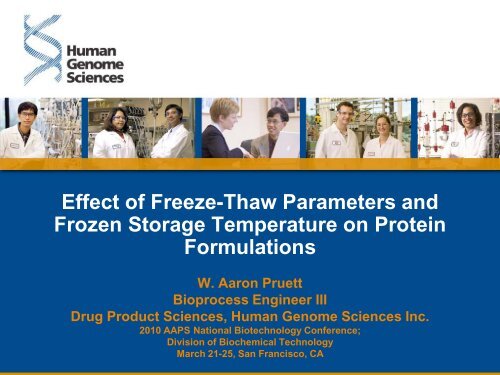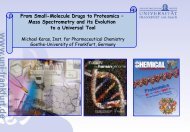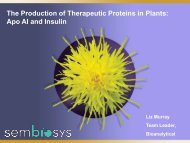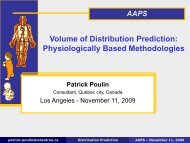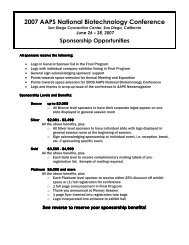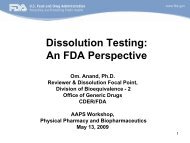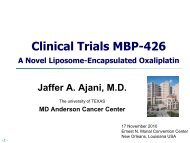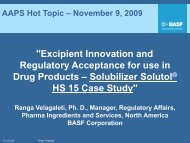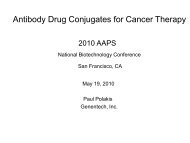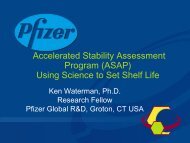Effect of Freeze-Thaw Parameters and Frozen Storage Temperature ...
Effect of Freeze-Thaw Parameters and Frozen Storage Temperature ...
Effect of Freeze-Thaw Parameters and Frozen Storage Temperature ...
- No tags were found...
Create successful ePaper yourself
Turn your PDF publications into a flip-book with our unique Google optimized e-Paper software.
<strong>Effect</strong> <strong>of</strong> <strong>Freeze</strong>-<strong>Thaw</strong> <strong>Parameters</strong> <strong>and</strong><strong>Frozen</strong> <strong>Storage</strong> <strong>Temperature</strong> on ProteinFormulationsW. Aaron PruettBioprocess Engineer IIIDrug Product Sciences, Human Genome Sciences Inc.2010 AAPS National Biotechnology Conference;Division <strong>of</strong> Biochemical TechnologyMarch 21-25, San Francisco, CA
<strong>Frozen</strong> storage <strong>of</strong> BDS: Process development• Process variables:• Container• Heating/cooling method• <strong>Storage</strong> temperature• Process development challenges• Scale tends to increase from early late stage• Small scale may not predict mfg. scale• Formulation effects:• Sub-freezing phase transitions> Protein <strong>and</strong> some excipients undergo glass transition> Some excipients may crystallize / form eutectic• Generation <strong>of</strong> new surface area• pH shifts• Ionic strength shift• Cryoconcentration makes other formulation effectsdependent on scale1
Cryoconcentration: freezingFREEZING AQUEOUSSOLUTION IN CONTAINERDENDRITIC ICE CRYSTALS GROWFROM HEAT TRANSFER SURFACEHEAT TRANSFER SURFACES1 2DIRECTIONAL ICE GROWTHT = freezing pointSOLUTE IS EXCLUDED FROM ICECRYSTALS FORMS DENSE CONCENTRATE3DENSE FREEZE CONCENTRATETENDS TO SINK THROUGH ANDAROUND THE ICE AS IT GROWSFROZEN AQUEOUSSOLUTION IN CONTAINER4DENSECONCENTRATEDSOLUTEICE CRYSTALGROWTH2
Cryoconcentration: thawingTHAWING AQUEOUSSOLUTION IN CONTAINERHEAT TRANSFER SURFACESMELTING AND CONVECTIONOF FREEZE CONCENTRATEFROM HEAT TRANSFERSURFACE1DIRECTIONAL HEATING ANDMELTING2C bottom > C topICE CRYSTALMELTINGCOMPLEX CONVECTIONDURING MELTING DUE TOSTRONG THERMAL ANDDENSITY GRADIENTSBOUYANT ICE MELT(ALMOST PURE WATER)3THERMAL CONVECTION ATHEAT TRANSFER SURFACEDENSE FREEZE CONCENTRATE(HIGH DISSOLVED SOLIDS)THAWED AQUEOUSSOLUTION IN CONTAINER4CONCENTRATIONSTRATIFICATIONCONTINUES UNTIL THAW ISCOMPLETE. MIXING ISREQUIRED TO ACHIEVEUNIFORM CONCENTRATION.FURTHER ENRICHMENT ATBOTTOM: C bottom >> C top3
Cryoconcentration: Concentration polarizationA GROWING ICE CRYSTAL IS VERY PURE WATER. SOLUTE ISEXCLUDED AND CONCENTRATES AT THE ICE-LIQUID INTERFACEDIRECTIONAL ICE GROWTH ALONG Z-AXISQuestion:If we get concentrationpolarization, shouldn’twe expect diffusivetransport?ICE CRYSTAL(100% WATER)WALLCONCENTRATION(C wall a , C wall b )BULK LIQUIDCONCENTRATION(C a , C b )yzDENSITY-DRIVENCONVECTION4
Cryoconcentration:Differential solute concentration250Solute concentration stratification <strong>of</strong> BSA with co-solute• Solutions <strong>of</strong> BSA (66 kD) +cosolute• Fast freeze (-80 o C)• Slow thaw (2-8 o C)• Sampled from top downmg/mL solute20015010050mg/mL sorbitol (MW = 182.2)mg/mL glucose (MW = 180.2)mg/mL sucrose (MW = 342.1)mg/mL 15 kD dextran00% 10% 20% 30% 40% 50% 60% 70% 80% 90% 100%BOTTOM% <strong>of</strong> total bed heightTOP• Cryoconcentrationobserved for all• Differential concentrationobserved with low MWsolutes• These results supportdiffusive separation model5Csolute / CBSA .Differential cryoconcentration BSA/co-solute solution(mg/mL sorbitol) / (mg/mL BSA)(mg/mL glucose) / (mg/mL BSA)(mg/mL sucrose) / (mg/mL BSA)(mg/mL dextran) / (mg/mL BSA)1009080706050400% 10% 20% 30% 40% 50% 60% 70% 80% 90% 100%BOTTOM% <strong>of</strong> total bed heightTOP
Case study: mAb A• High con. mAb A (> 60 mg/mL), sucrose, glycine, buffer• lyophilization compatible• T g ’: -33 o C, T e : -5 o C (sometimes)• Aggregation <strong>and</strong> precipitation at -40 o C <strong>and</strong> -20 o C (in bags)• <strong>Frozen</strong> <strong>and</strong> stored at -80 o C, thawed at room temp• Purpose <strong>of</strong> study• Investigate sensitivity to freezing rate• Explain aggregation below T g ’6
AU1. 801. 701. 601. 501. 401. 301. 201. 101. 000. 900. 800. 700. 600. 500. 400. 300. 200. 100. 00- 0 . 100 . 0 2.00 4.00 6. 00 8. 00 10.00 12.00 14.00 16. 00 18. 00 20.00 22.00 24.00 26. 00 28. 00 30.00 32.00 34.00Minut esmAb A: Aggregation at -40• Froze aliquots to -40 o C in 30 mL Celsius-Pak bags• Within 3 days, aggregate level increases from 0.3% to approx.1%, then levels <strong>of</strong>f.AGGREGATEMAIN PEAK-80 CONTROL0.25 DAY -401 DAY -403 DAY -4021 DAY -40% aggregate1.21.00.80.60.40.2Aggregate levels in mAb A stored at -40 o CCONTROL0.00 3 6 9 12 15 18 21Days at -40 o C7
Investigated freezing rate coupled withhold time• Investigated effect <strong>of</strong>freezing rate to -40 o C• Protein was held at -40 o Con DSC stage in covered50 µL pan• Little change in aggregatecompared to bag• Direct effect <strong>of</strong> scale onstability?FreezingmethodDSC-0.1 o C/minDSC-10 o C/minDSC-0.1 o C/minDSC-10 o C/minQuiescent-1 to -2 o C/minControlled-0.1 o C/min-80 control(Tg’ = -33 o C)-40 Hold(hours)T g ’T e(-5 o C)Change in %aggregate72 NO 1.9 J/g 0.272 NO 2.9 J/g 0.34 NO 3.9 J/g 0.14 -38,-300.1 J/g 0.172 N/A N/A 0.772 N/A N/A 0.7N/A N/A N/A 0.08
Investigated scaling factor: cryoconcentration0.0Heat Flow (W/g)-0.5-1.0Control at 1 o C/min<strong>Freeze</strong> concentrate (BOTTOM) at1 o C/minT e at -5 o C-1.59-2.0Exo Up-80 -60 -40 -20 0<strong>Temperature</strong> (°C)
Investigated scaling factor: cryoconcentration-0.04Control at 1 o C/min<strong>Freeze</strong> concentrate at 1 o C/minHeat Flow (W/g)-0.06-0.08-0.10Strong T g ’ observed in the freezeconcentrate at -39 o CIn both cases, no T g ’ observed after annealing-0.12-70 -60 -50 -40 -30 -20 -<strong>Temperature</strong> (°C)Universal V4.5AExo UpAt -40 o C, glycine eutectic formation accelerated atlarger scale due to freeze concentration.11
<strong>Effect</strong> <strong>of</strong> composition <strong>and</strong> scale onaggregate formationSampleBDS control(0.3% @ -80)% aggregate after time at -40 o C% aggregate4 hour @ -40(DSC pan)% aggregate72 hour @ -40(DSC pan)% aggregate72 hour @ -40(30 mL bag)% aggregate21 day @ -40(30 mL bag)0.4 0.5 1.0 1.0<strong>Freeze</strong> concentrate 0.4 -- -- 1.0High glycine 1.7 -- -- 3.3High sucrose 0.3 -- -- 0.6• High glycine has increased aggregate.• <strong>Freeze</strong> concentrate does not.• High sucrose has lowest aggregate.• Scale effect likely due eutectic formation kinetics.12
<strong>Effect</strong> <strong>of</strong> composition <strong>and</strong> scale onaggregate formationCONCLUSIONS• Cryoconcentration is not directly causing aggregation• At large enough scale, cryoconcentration is lowering T g ’ in someregions• At lower T g ’, glycine eutectic forms faster at -40 o C, promotingaggregation• Based on these results, scale must be taken into account whenevaluating freeze-thaw for this product.13
Proposed model for small-scale processcharacterization studies• 1) Characterize the product at small-scale• 2) Develop surrogate for mfg. scale study• 3) Characterize manufacturing-scale with surrogate• 4) Apply manufacturing-scale conditions to scale-downmodel• 5) Apply scaling factors to scale-down model asnecessary14
Develop surrogate for mfg. scale study• Surrogate solutions mimic BDS to obtain manufacturingscale information• Process duration• Time-temperature pr<strong>of</strong>iles at scale• Cryoconcentration• pH shift / chemical conditions• To optimize quality <strong>of</strong> surrogate data, evaluate heat <strong>and</strong>mass transfer properties <strong>of</strong> product vs. surrogate15
Cryoconcentration <strong>and</strong> pH shift• Cryoconcentration can affectchemical conditions in concentratepH shift in freezingon a scale-downsystem• Eutectic crystallization may beslowed by concentration <strong>of</strong> otherexcipients• Disodium phosphate T e is -0.5 o C• Sodium phosphate buffer +pH indicator used to mapcryoconcentration16
20 mM phosphatepH 7.820 mM phosphate1.2% sucrosepH 7.8pH 4.0pH 5.0pH 6.0pH 7.0pH 8.020 mM phosphate80% sucrose pH7.85 mM phosphate3.2 % sucrose pH7.850 mM phosphate3.2 % sucrose pH7.817
Sampled throughoutbag.pH 6.2-7.8 (bulk = 7.6)osmolality140 – 380 mOsm(bulk = 150 mOsm)19
Heat transfer: <strong>Effect</strong> <strong>of</strong> formulation on thermal history5<strong>Thaw</strong>ing pr<strong>of</strong>ile for 1 L bottles:water, buffer <strong>and</strong> a BDS surrogate solution<strong>Temperature</strong> o C0-5-10-15-20WaterBufferBDS surrogate0 5 10 15hoursdisodium phosphate Te: -0.5 o CTime between BDS T g ' <strong>and</strong> Te:water: 0.8 hoursbuffer: 3 hourssurrogate: 5.1 hours20
Heat transfer: Latent heat <strong>of</strong> fusion∆H H (kJ/kg) ∆H (kJ/kg) H kJ/kgEnthalpy change for freezing / thawing water600For water:500 For H fusionwater: = 333 kJ/kg∆H400fusion = 334 kJ/kg3002001000-80 -60 -40 -20 0 20<strong>Temperature</strong> o CEnthalpy change for freezing / thawing water600For water:500For H fusion amorphous = 333 kJ/kg system,400 increasing dissolvedsolidsIncreasingdecreasesliquid/amorphous∆H fusion300 solutes decreases H fusion200100∆H H (kJ/kg)350300250200150100500Enthalpy change for freezing / thawing water0 20 40 60 80weight % sucrose210-80 -60 -40 -20 0 20<strong>Temperature</strong> o C
Heat transfer: ∆H vs. thermal conductivity• Based on enthalpy change:• Increasing solids content should reduce thaw time• Water should be a worst case for slowest freeze / thawminutes to thawminutes to thaw212018019170181716016150151401413013120Time to thaw sucrose solutions from -80 o C at 50 o C / 60%RHTime to thaw sucrose solutions from -80 o C at 50 o C / 60%RH13 mL in centrifuge tube400 mL in PETG bottles12110010050 100 150 200 250 300 350 400 4500 50 100 150 mg/mL 200 sucrose 250 300 350 400 450mg/mL sucrose90 mg/mL sucroseconsistently tooklongest to thaw22
Heat transfer: thermal conductivity• Direct measurement <strong>of</strong> sub-freezing thermalconductivity challenging• k = (q/A) / (∆T/∆x) : steady statehttp://www.decagon.com/thermal/kd2pro/index.php?pg=overview• Alternate method: Transient line heat source• Heated needle measures dT/dt from applied heatflux• Fits temperature versus time data to solve for k• Used modified KD2 Pro system from DecagonDevices23
Heat transfer: thermal conductivity• Thermal conductivity measured for frozen sucrosesolutions• Slowest to thaw (90 mg/mL sucrose) had 40%lower conductivity compared to water2.4Measuring frozen thermal conductivity with a hotwire probeThermal conductivity (W/mK)2.22.01.81.61.41.21.0-40oC-20oC240.80 50 100 150 200 250 300 350 400 450mg/mL sucrose
Heat <strong>and</strong> mass transfer summary• Mass transfer• Cryoconcentration occurs during freezing <strong>and</strong> thawing• Differential separation <strong>of</strong> solutes driven by diffusion (even withno T e )• Cryoconcentration mapping with sodium phosphate / pHindicator system• Heat transfer• Composition affects thermal history• At low concentrations, dissolved solids have a strong effect onthermal conductivity• Water not an ideal surrogate for scaling studies25
Conclusions• Small-scale methods can improve underst<strong>and</strong>ing <strong>of</strong>freeze-thaw process• Small scale studies may be used to:• Identify process excursion limits• Identify vulnerabilities• Inform container selection process development• Surrogate selection is important in:• Developing correct process-scale temperature pr<strong>of</strong>ile• Identifying process-scale cryoconcentration <strong>and</strong> mass transfereffects26
Acknowledgements• Jeffery Palombo• Rich Affleck• Neçois Penn• Eugene Wu• Arpan Nayak• Doug Cobos• Kendra Woodberry• Dominique Duong• Tesfu Mezghebe• James Col<strong>and</strong>ene• Melissa Perkins• Tom SpitznagelRecommended readingLam, P., Moore, J., “Freezing Biopharmaceutical Products”, Encyclopedia <strong>of</strong> IndustrialBiotechnology: Bioprocess, Bioseparation, <strong>and</strong> Cell Technology, Ed. Michael C. Flickinger,7 vols., John Wiley & Sons, 2010, pp 2567-258127


